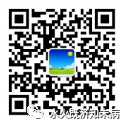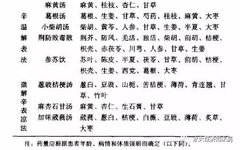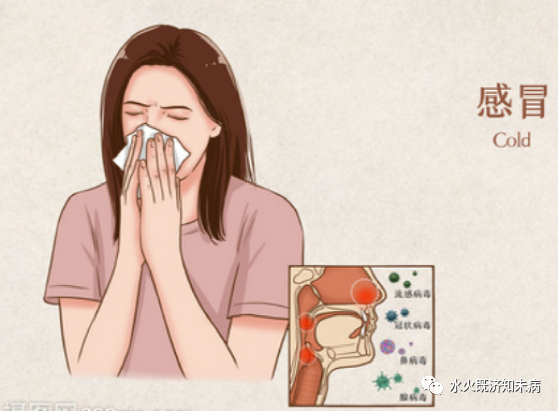
1.Identification of Exogenous Pathogens(1), Epidemic FactorsThe pathogen of influenza is a filterable virus. However, due to the existence of different types of viruses and their mutations, the complexity of the influenza epidemic pattern increases. Although traditional Chinese medicine (TCM) has not directly observed pathogens, it has noted the external factors of the natural environment and climate, and their influence on the patterns of influenza epidemics.The ancients referred to “violent cold,” “wind evil,” and “seasonal aberrant qi,” which, while not explicitly indicating viruses, suggest that these factors are triggers for influenza epidemics. It is also recognized that influenza is transmitted through the respiratory tract and that methods for preventing its occurrence are essential.(2), Epidemic SeasonsTraditional Chinese medicine states, “In spring, it should be warm but turns cold; in summer, it should be hot but turns cool; in autumn, it should be cool but turns hot; in winter, it should be cold but turns warm. Thus, throughout the year, diseases appear similarly due to the aberrant qi of the seasons.” This indicates that non-seasonal qi can also cause the spread of diseases. However, there are also cases where diseases occur not due to non-seasonal qi, known as the six qi of exogenous pathogens.Therefore, when diagnosing influenza, it is necessary to analyze both non-seasonal qi and seasonal evils, depending on the time. For example, in winter, when the cold water is the dominant qi, if one wears thin clothing and is exposed to cold evil, symptoms such as aversion to cold, fever, headache, and no sweating with a floating tight pulse indicate that the seasonal cold evil is the cause of the illness. If the climate unexpectedly warms and one falls ill due to this, it indicates that non-seasonal qi is the cause, and treatment should be sought within the winter warming methods.In spring, when the wind wood is the dominant qi, if one catches a cold with wind evil, initially feeling slightly cold but later only feeling hot, with symptoms like headache, body aches, thirst, cough, or spontaneous sweating, and a floating rapid pulse, it indicates wind warmth, which is also a seasonal evil. If the cold water qi has not dissipated, or if the climate suddenly turns cold, and one falls ill, it indicates that non-seasonal qi is the cause, and treatment should be sought for cold evil. In summer, the predominant conditions are heat and summer heat, while in late summer, both heat and dampness are common; in autumn, dryness prevails, which can be of two natures: cool or warm, leading to both cool dryness and warm dryness types.Based on the different seasons, the cold and warmth vary, thus the symptoms of influenza also change with the seasons. In clinical practice, “examining the disease mechanism without losing the appropriate qi” can achieve the treatment effect of “subduing the main issue while addressing the cause.”(3), Disease Process and ClassificationThe onset of influenza is rapid, with symptoms peaking within 1-2 days, and various symptoms may gradually disappear, leaving extreme weakness and reduced vitality. Simple influenza rarely lasts more than 5-7 days. Sometimes, on the 3rd or 4th day, the temperature drops, and the illness improves. At times, 1-2 days later, the temperature may rise again, worsening the condition, presenting a biphasic temperature curve. In very mild cases, the entire course lasts 1-2 days, and the patient does not need to stay in bed. In severe cases, various systemic toxic symptoms may appear, even leading to collapse or rapid death.The clinical manifestations of influenza are diverse, leading to many classification methods. Essentially, it can be divided into three types: simple, mixed, and secondary infections.According to TCM characteristics, it is necessary to combine epidemic factors and the season of onset for analysis. If the illness is solely due to seasonal evils, or due to cold or wind without other factors, it is mostly a simple cold.If the climate is unusual and mixed with improper qi, the changes in the illness are complex, often leading to a mixed cold.Additionally, individual constitution varies, susceptibility differs, age varies, and regions differ in dryness and dampness, as well as the sites of viral invasion. For example, there may be Taiyang syndrome with headache and fever, floating pulse with aversion to cold; Yangming syndrome with dry nose and eye pain, fever, stiff neck, thirst, and sweating; Shaoyang syndrome with bitter mouth, dry throat, alternating chills and fever, chest and hypochondriac pain, and preference for vomiting; or even simultaneous manifestations of three Yang syndromes, with treatment focused on the predominant meridian. There may also be direct involvement of three Yin syndromes, treated according to the affected meridian.Moreover, there are cases of colds combined with food stagnation or phlegm, which must be carefully distinguished (food stagnation requires digestive herbs, phlegm requires phlegm-transforming herbs) to avoid misdiagnosis.As for secondary symptoms of influenza, pneumonia is the most common, and it must be viewed in light of the secondary infection situation, whether due to untimely treatment or inadequate regulation, and treated accordingly.2.Principles of Treatment for Exogenous PathogensInfluenza is classified as an exogenous disease, and the principles for treating influenza primarily involve releasing the exterior, which can be divided into two main methods: warming and cooling. Based on the factors and seasons of influenza onset, one should distinguish between warming and cooling methods, and further analyze any accompanying factors to simplify the treatment and grasp the essentials.(1)Winter Treatment for InfluenzaWinter influenza can be divided into two categories: cold evil (treated similarly to typhoid) and response to cold with non-seasonal qi (treated similarly to winter warming methods).1.Cold EvilSymptoms include aversion to cold, fever, headache, body aches, floating tight pulse, no sweating, white tongue, no thirst, and tongue not red; Ma Huang Tang (Ephedra Decoction) can be used. For fever, headache, body aches, stiff neck, floating long pulse with no sweating, Ge Gen Tang (Kudzu Decoction) can be used. For alternating chills and fever, bitter mouth, dry throat, chest fullness, dizziness, preference for vomiting, and floating wiry pulse, Xiao Chai Hu Tang (Minor Bupleurum Decoction) can be used. For aversion to wind and cold, headache, body aches, chest tightness with no thirst, white tongue coating, and floating pulse, Jing Fang Bai Du San (Schizonepeta and Fangfeng Powder) can be used. For aversion to wind and cold with cough, slight body aches, white tongue coating, floating pulse, and body weakness, Shen Su Yin (Ginseng and Perilla Leaf Decoction) can be used.Although these are all warming methods to release the exterior, the symptoms differ, and the constitution varies, so prescriptions should be treated accordingly.2.Response to Non-Seasonal QiSymptoms include high fever, slight aversion to cold or no aversion to cold, headache, nasal congestion, white or slightly yellow tongue coating, slight thirst, and floating rapid pulse; Cong Chi Jie Geng Tang (Scallion, Soybean, and Platycodon Decoction) can be used for cooling. If there is slight fever with aversion to cold, no sweating or sweating that does not penetrate, slight irritability, slight redness of the face, slight redness of the eyes (facial redness indicates that Yang qi is constrained at the surface), thirst, white or slightly yellow tongue coating that is not dry, red tongue that is not dark, floating rapid pulse with tightness, and accompanying cough and shortness of breath, it indicates internal heat constrained by external cold, with pulse qi being restricted, belonging to cold wrapping fire, and cooling dispersing agents such as Ma Xing Shi Gan Tang (Ephedra, Apricot Kernel, Gypsum, and Licorice Decoction) can be used. If the body is weak and catches a cold in winter, with cough, dry throat, fever, and headache, Add Wei Rui Tang (Modified Houttuynia Decoction) can be selected.These are slightly cooling methods to release the exterior, as winter should be cold but can turn warm, thus the selection of formulas should not purely rely on bitter cold but should be slightly cooling and dispersing (see Table 1).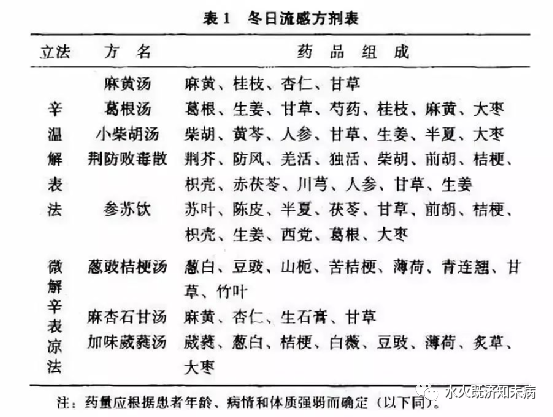 (2)Spring Treatment for InfluenzaThis can be divided into wind warmth (treated similarly to wind warmth and dampness) and non-seasonal cold (treated similarly to cold epidemic).1.Wind EvilSymptoms include fever without aversion to cold or slight aversion to cold, no thirst or slight thirst, headache, sweating or incomplete sweating, or slight cough, thin white tongue coating, floating rapid pulse; either Yin Qiao San (Honeysuckle and Forsythia Powder) or Sang Ju Yin (Mulberry Leaf and Chrysanthemum Decoction) can be used. Since wind is a Yang evil and spring is warm, according to the “Inner Canon” stating “wind invades internally, treated with warming and cooling,” the proper method is to use “warming and cooling to release the exterior.”2.Cold EpidemicSymptoms include aversion to cold, fever, headache, body itching, chest tightness with no appetite, no sweating, white tongue, floating pulse; Xiang Su Yin (Aromatic Perilla Decoction) can be used, or with Cong Chi Tang (Scallion and Soybean Decoction). For aversion to cold with fever or chills, headache, body aches, cough, no sweating, no thirst, white and foul tongue coating, no appetite, floating tight or floating wiry pulse, Shi Shen Tang (Ten Gods Decoction) or Su Qiang Yin (Perilla Decoction) can be used (see Table 2).
(2)Spring Treatment for InfluenzaThis can be divided into wind warmth (treated similarly to wind warmth and dampness) and non-seasonal cold (treated similarly to cold epidemic).1.Wind EvilSymptoms include fever without aversion to cold or slight aversion to cold, no thirst or slight thirst, headache, sweating or incomplete sweating, or slight cough, thin white tongue coating, floating rapid pulse; either Yin Qiao San (Honeysuckle and Forsythia Powder) or Sang Ju Yin (Mulberry Leaf and Chrysanthemum Decoction) can be used. Since wind is a Yang evil and spring is warm, according to the “Inner Canon” stating “wind invades internally, treated with warming and cooling,” the proper method is to use “warming and cooling to release the exterior.”2.Cold EpidemicSymptoms include aversion to cold, fever, headache, body itching, chest tightness with no appetite, no sweating, white tongue, floating pulse; Xiang Su Yin (Aromatic Perilla Decoction) can be used, or with Cong Chi Tang (Scallion and Soybean Decoction). For aversion to cold with fever or chills, headache, body aches, cough, no sweating, no thirst, white and foul tongue coating, no appetite, floating tight or floating wiry pulse, Shi Shen Tang (Ten Gods Decoction) or Su Qiang Yin (Perilla Decoction) can be used (see Table 2).
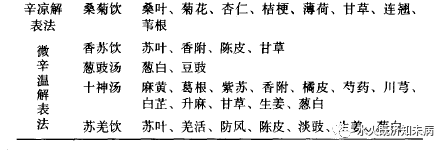 (3)Summer Treatment for InfluenzaIn summer, it is often hot, and symptoms include headache, body aches, fever, thirst, no sweating, white tongue, floating rapid pulse; Yin Qiao San can be used with added apricot kernel and talc. For fever, thirst, irritability, headache, and sweating, Yin Qiao San can be used with the removal of mustard seed and burdock seed, adding apricot kernel, Huang Qin (Scutellaria), and Sheng Shi Gao (Gypsum); for severe thirst, add pollen; for chest tightness, add Huo Xiang (Agastache) and Yu Jin (Curcuma); for short urination, add Zhi Zi (Gardenia) or Liu Yi San (Six One Powder). If there is fever, headache, dizziness, nausea, vomiting, chest tightness, fatigue, abdominal pain, diarrhea, white slippery or slightly greasy tongue, with or without thirst, it indicates summer heat and food stagnation, and Huo Xiang Zheng Qi San (Agastache Correct Qi Powder) can be used.(4)Late Summer Treatment for InfluenzaThis season is characterized by the combination of heat, dampness, and wind. Particularly, heat and dampness are often predominant. If one catches a cold due to summer heat, with solid exterior, no sweating, fever, headache, white tongue coating, red face, and thirst, Xin Jia Xiang Ruo Yin (Newly Added Aromatic Perilla Decoction) is appropriate; if the tongue tip is red, a small amount of Huang Lian (Coptis) can be added, and if urination is short, Liu Yi San can also be added. If one catches a cold with summer heat and dampness, with nausea, vomiting, dizziness, body aches, fatigue, diarrhea, no appetite, fever, and no thirst, Liu He Tang (Liu He Decoction) can be used. If one catches a cold with predominant dampness, with headache as if wrapped, heavy body, joint pain, white slippery tongue, no thirst or appetite, floating pulse, and increased heat in the afternoon, San Ren Tang (Three Seed Decoction) can be used. If the pulse is slow with body aches, yellow slippery tongue coating, little thirst or no thirst, sweating reduces heat, then heat returns, it indicates internal dampness from food and external dampness from seasonal factors, and Huang Qin and Shi Gao Decoction can be used. If wind and dampness rise, with headache and back pain, Qiang Huo Sheng Shi Tang (Notopterygium Decoction) can be selected.In summary, influenza in summer, especially in late summer, is influenced by wind, heat, and dampness, thus the treatment methods include warming and cooling to dispel evils, aromatic clearing, and promoting yang and draining dampness. In clinical application, it is essential to grasp the disease mechanism and apply flexibly (see Table 3).
(3)Summer Treatment for InfluenzaIn summer, it is often hot, and symptoms include headache, body aches, fever, thirst, no sweating, white tongue, floating rapid pulse; Yin Qiao San can be used with added apricot kernel and talc. For fever, thirst, irritability, headache, and sweating, Yin Qiao San can be used with the removal of mustard seed and burdock seed, adding apricot kernel, Huang Qin (Scutellaria), and Sheng Shi Gao (Gypsum); for severe thirst, add pollen; for chest tightness, add Huo Xiang (Agastache) and Yu Jin (Curcuma); for short urination, add Zhi Zi (Gardenia) or Liu Yi San (Six One Powder). If there is fever, headache, dizziness, nausea, vomiting, chest tightness, fatigue, abdominal pain, diarrhea, white slippery or slightly greasy tongue, with or without thirst, it indicates summer heat and food stagnation, and Huo Xiang Zheng Qi San (Agastache Correct Qi Powder) can be used.(4)Late Summer Treatment for InfluenzaThis season is characterized by the combination of heat, dampness, and wind. Particularly, heat and dampness are often predominant. If one catches a cold due to summer heat, with solid exterior, no sweating, fever, headache, white tongue coating, red face, and thirst, Xin Jia Xiang Ruo Yin (Newly Added Aromatic Perilla Decoction) is appropriate; if the tongue tip is red, a small amount of Huang Lian (Coptis) can be added, and if urination is short, Liu Yi San can also be added. If one catches a cold with summer heat and dampness, with nausea, vomiting, dizziness, body aches, fatigue, diarrhea, no appetite, fever, and no thirst, Liu He Tang (Liu He Decoction) can be used. If one catches a cold with predominant dampness, with headache as if wrapped, heavy body, joint pain, white slippery tongue, no thirst or appetite, floating pulse, and increased heat in the afternoon, San Ren Tang (Three Seed Decoction) can be used. If the pulse is slow with body aches, yellow slippery tongue coating, little thirst or no thirst, sweating reduces heat, then heat returns, it indicates internal dampness from food and external dampness from seasonal factors, and Huang Qin and Shi Gao Decoction can be used. If wind and dampness rise, with headache and back pain, Qiang Huo Sheng Shi Tang (Notopterygium Decoction) can be selected.In summary, influenza in summer, especially in late summer, is influenced by wind, heat, and dampness, thus the treatment methods include warming and cooling to dispel evils, aromatic clearing, and promoting yang and draining dampness. In clinical application, it is essential to grasp the disease mechanism and apply flexibly (see Table 3).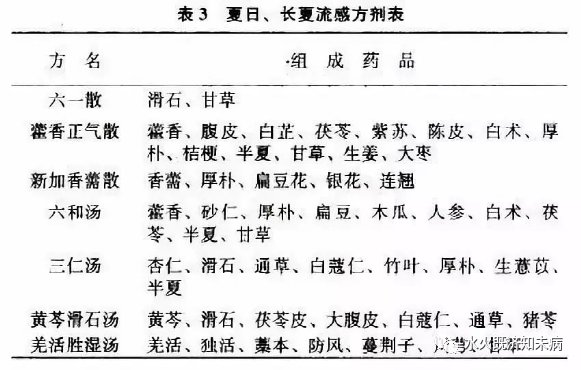 (5)Autumn Treatment for InfluenzaSymptoms include headache, aversion to cold, fever, nasal congestion, dry throat, cough with thin phlegm, wiry pulse with no sweating, indicating cool dryness; Xing Su San (Apricot and Perilla Powder) can be used. For headache, slight fever, slight thirst, cough with sweating, Sang Ju Yin can be used. For slight headache, unclear vision, slight thirst, dry cough, and unresolved residual evil, Qing Luo Yin (Clear Collaterals Decoction) can be used. For cough with little or yellow phlegm, dry throat, thirst, red tongue with no coating, and rapid pulse, Qing Zao Jiu Fei Tang (Clear Dryness and Rescue Lung Decoction) can be used (see Table 4).
(5)Autumn Treatment for InfluenzaSymptoms include headache, aversion to cold, fever, nasal congestion, dry throat, cough with thin phlegm, wiry pulse with no sweating, indicating cool dryness; Xing Su San (Apricot and Perilla Powder) can be used. For headache, slight fever, slight thirst, cough with sweating, Sang Ju Yin can be used. For slight headache, unclear vision, slight thirst, dry cough, and unresolved residual evil, Qing Luo Yin (Clear Collaterals Decoction) can be used. For cough with little or yellow phlegm, dry throat, thirst, red tongue with no coating, and rapid pulse, Qing Zao Jiu Fei Tang (Clear Dryness and Rescue Lung Decoction) can be used (see Table 4).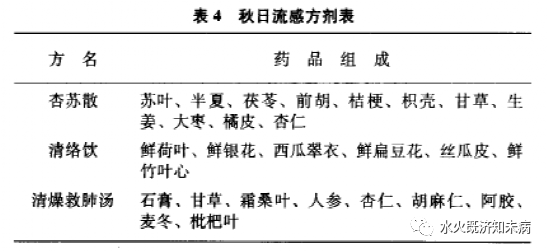 These are the general treatment principles for seasonal influenza. They can be interchanged and applied separately without being rigid. The methods and formulas listed are for clinical reference only and must be adjusted according to individual, location, and timing. Additionally, formulas such as Jiu Wei Qiang Huo Tang, Hai Zang Shen Shu San, and Su Shen Jiu Bao Tang are also available for treating influenza. Traditional Chinese medicine is very rich, and it cannot be fully represented by one formula or a few methods for treating influenza.This is a platform for sharing TCM knowledge; a place for differentiation and discussion of treatment. Friends who love TCM, please follow and share!!!
These are the general treatment principles for seasonal influenza. They can be interchanged and applied separately without being rigid. The methods and formulas listed are for clinical reference only and must be adjusted according to individual, location, and timing. Additionally, formulas such as Jiu Wei Qiang Huo Tang, Hai Zang Shen Shu San, and Su Shen Jiu Bao Tang are also available for treating influenza. Traditional Chinese medicine is very rich, and it cannot be fully represented by one formula or a few methods for treating influenza.This is a platform for sharing TCM knowledge; a place for differentiation and discussion of treatment. Friends who love TCM, please follow and share!!! 